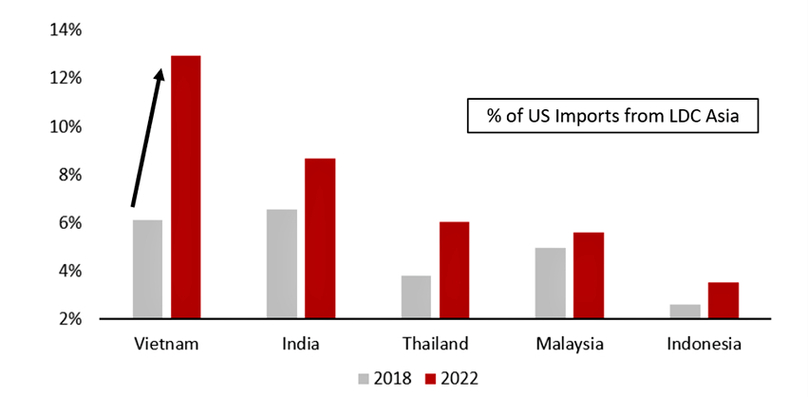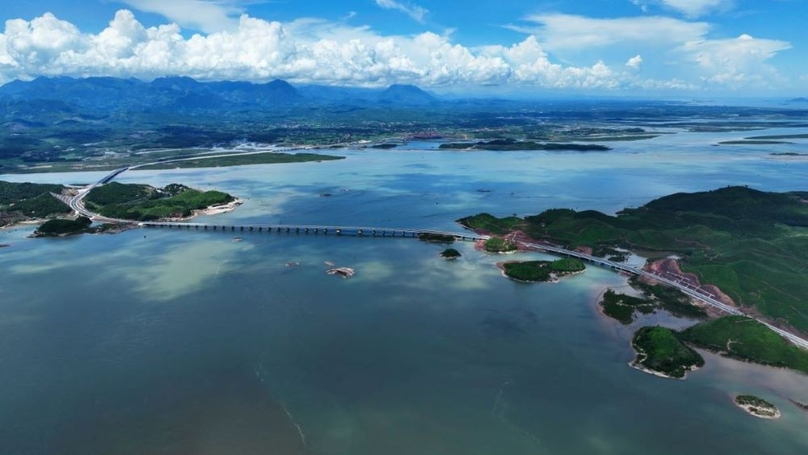Vietnam's FDI inflows to remain resilient
VinaCapital’s chief economist Michael Kokalari points out reasons why Vietnam continues to be a prime destination for foreign direct investment (FDI), particularly from multinationals looking to produce for export and seeking an alternative and/or additional manufacturing base to China.

FDI is one of Vietnam's most important growth drivers, and Vietnam’s FDI inflow has benefitted more than any other country’s from the U.S.-China trade war. However, two potential risks to Vietnam’s future FDI inflow recently caught the attention of local business leaders and government policy makers:
First, Vietnam could be losing its competitiveness as an FDI destination versus India, Malaysia and/or Indonesia. Second, a new global corporate minimum tax scheme would reduce Vietnam’s relative attractiveness as an FDI destination by limiting tax incentives offered to prospective investors.
Tim Cook’s visit to India in April spawned a plethora of articles on the intentions of Apple and others to build new factories in the country. But it is important to note that most products produced in those factories will be sold on the Indian market. In short, new investments to India are not being motivated by the “China + 1” investment strategy that drove FDI inflow into Vietnam over the last decade, particularly at an accelerated pace since the start of the U.S.-China trade war.
Some observers have also noted that planned FDI into Malaysia and Indonesia surged during the last two years, while Vietnam’s registered FDI was essentially flat. However, as we discuss below, investments into Malaysia and Indonesia were largely channeled into the production of goods Vietnam does not make, including electric vehicle (EV) batteries.
Finally, Vietnam has attracted far more than its “fair” share of FDI since the U.S.-China trade war emerged in 2018, so some of Vietnam’s regional competitors for FDI inflow are now experiencing some “catch up” investments after lagging behind Vietnam in recent years. But we believe it is likely that Vietnam will continue to be the biggest beneficiary of “China + 1”- motivated investments in the years ahead for reasons discussed in the next section of this report.
Vietnam, the preferred 'China + 1' destination for multinationals
The U.S.-China trade war emerged in 2018, and from then until 2022, China’s share of exports to the U.S. plunged by about 13%, from 69% of total exports from Less Developed Countries (LDC) in Asia (including India) to 56% of LDC Asia exports to the U.S. Vietnam absorbed about half of China’s drop in export market share, increasing its own share of exports to the U.S. from 6% in 2018 to 13% in 2022.
Vietnam has benefited the most from the China-U.S. trade war

Vietnam has been the biggest beneficiary of the U.S.-China trade war because the country’s three key strengths as an FDI destination propelled investments by multinationals, which in turn drove the country’s surging exports.
First and foremost, factory wages in Vietnam are less than half those in China, while the quality of the workforce is comparable to China's according to surveys by JETRO (Japan External Trade Organization) and others. Vietnam also has close geographic proximity to the supply chains in Asia, especially for the production of high-tech products.
And finally, Vietnam benefits from the so-called “friendshoring” phenomenon in which multinational firms increasingly invest in countries that are perceived as having minimal risk of having steep tariffs put on their exports to the U.S. Vietnam’s appeal in that regard increased significantly this year in the wake of visits to the country from U.S. Secretary of State Antony Blinken as well as the biggest-ever delegation of leading U.S. firms, both of which followed a call between President Biden and Nguyen Phu Trong, Vietnam’s Party General Secretary.
India not a threat to Vietnam's FDI inflow yet
Apple’s April announcement of ambitious plans to expand its iPhone production in India generated a lot of news, but it is consistent with other multinational firms that are investing in India primarily to manufacture products to be sold to Indian consumers, which is very different than their motivation for investing in Vietnam.
Vietnam is pursuing the so-called “East Asian Development Model,” which is the same approach that the “Asian Tiger” economies used to become wealthy. This economic growth strategy is focused on manufacturing products that are exported to the U.S. and other developed countries, and multinational firms that invest in Vietnam are contributing to that endeavor; nearly all of the products they produce in Vietnam are exported, especially to the U.S., which is Vietnam’s largest export market (at over one-quarter of Vietnam’s exports).
In contrast, India is pursuing a more domestic-oriented growth strategy, so multinational firms investing in that country are seeking to profit from its rapidly growing middle class rather than as a production base from which to export. For example, Apple iPhone sales in India have exploded in recent years, as can be seen in the table below, so Apple has been pouring money into India to increase its local iPhone production capacity, which has not kept pace with local demand. Of the 7 million phones the company sold in India last year, only 6.5 million were produced locally, with the balance imported to meet demand, illustrating why Apple’s immediate motivation to invest in India is to address surging local demand.
Obstacles to export production in India
Two key issues are preventing multinational companies from aggressively investing in India to produce goods for export: workforce-related issues (including literacy) and India’s strict labor laws. For example, factories in India with more than 100 employees require government approval before laying off any employees, and India’s “Made in India” program, which was launched in 2015 to attract manufacturing FDI (partly with tax incentives) is widely recognized as having failed to attract foreign investment, partly for these reasons. These dynamics could change in the future, however, as Apple and others have been pressuring India to improve its attractiveness as an FDI destination because of their desire to diversify production out of China for geopolitical and other reasons.
Last year, Vietnam’s “Ease of Doing Business” ranking in the Economist Intelligence Unit (EIU) rating of countries around the world leaped by 12 places, which was the largest improvement in any of the 82 countries the EIU assesses; India’s ranking also increased, albeit by six places. In contrast, China’s ranking fell by 11 places, and the country now ranks below both Vietnam and India.
We do not see India threatening Vietnam’s FDI inflow and continue to believe FDI is likely to remain one of Vietnam’s key growth drivers for years to come. The current wave of new FDI announcements in India should not be viewed as taking investment away from Vietnam.
Malaysia, Indonesia benefit from EVs, cloud computing
Planned foreign investment in Malaysia and Indonesia surged at a near 65% rate and 30% rate (CAGR), respectively, over the last two years, while Vietnam’s registered FDI was essentially flat, and fell in the first four months of this year. Some observers have interpreted this to mean that multinationals may be setting up factories in Malaysia and Indonesia instead of Vietnam, but both of those countries are benefitting from a surge of investments into EV battery production, and Malaysia is attracting considerable investment into data centers that benefit from cloud computing.
For example, Tesla, BYD, and Hyundai are investing in EV battery production in Indonesia, and Samsung is investing in Malaysia. In Indonesia, such investments are motivated by an abundance of “green metals” in the country as well as the country’s strategy to encourage investment in downstream commodities industries (Indonesia banned the export of unprocessed nickel last year, for example). Malaysia is also experiencing a boom in data center and cloud computing-related investments, which grew 4,000% last year, driven by investments by Amazon Web Services, Byte Dance systems, and Bridge Data Centers.
Vietnam's high-tech foreign investments are still focused on the assembly of consumer and other electronics as the country's capabilities do not yet extend to higher value-added businesses like data centers and cloud computing. But it is important to keep in mind that Malaysia’s climb up the high-tech value chain also started with the assembly of electronic products, so Malaysia’s success can be viewed as an indicator of where Vietnam is likely to be in the future.
Global minimum tax won’t dampen Vietnam’s FDI inflow
FDI companies that invest in Vietnam typically enjoy tax breaks that may include a 0% tax rate during the initial years of their operations in Vietnam, followed by a gradual increase up to Vietnam’s full 20% corporate income tax rate over a period as long as 10 years.
In 2021, over 100 countries (including Vietnam) agreed to an OECD proposal for a global corporate minimum tax (GMT) that would impose a 15% minimum corporate tax rate on income for companies with consolidated incomes above circa $850 million, starting from 2023. The implementation of this agreement was subsequently delayed to 2024, and it is not clear yet whether the U.S., China, and India will participate in the scheme.
Vietnam has been preparing for the implementation of the new GMT system next year, and it has been reported that around 70 companies in Vietnam could see their tax rates rise if it is imposed. Some of Vietnam’s regional emerging market peers are reportedly investigating alternative schemes in which some of the additional tax revenues would be channeled into a “business support fund” that would effectively offset companies’ higher tax burdens by subsidizing some of those firms’ production costs (for example, with subsidized electricity prices, spending on the construction of a new factory, worker housing, etc.).
More importantly, low tax rates are far from the most important factor in a company’s decision about where to establish a new factory, according to surveys from the World Bank and others. Considerations like political stability, ease-of-doing-business, workforce (quality and wages), and physical infrastructure are all more important factors.
The net conclusion of all of the above is that the new GMT is unlikely to impede Vietnam’s FDI inflow given the fact that tax incentives are not the primary attraction for setting up a factory in Vietnam, and it seems likely that workarounds to the GMT are likely to be put in place, if-and-when the scheme is actually implemented.

A section of the Van Don-Mong Cai Expressway, which links the investment hub of Van Don in Quang Ninh with the northern province's Mong Cai border town. Photo courtesy of the investor Sun Group.
Conclusion
FDI has been one of Vietnam’s most important economic growth drivers over the last decade. Vietnam has significantly outperformed its regional peers in attracting FDI since the U.S.-China trade war emerged, but concerns have been raised about Vietnam’s continued competitive advantage amid growing interest in India from firms like Apple and others.
We are not overly concerned that India will affect FDI that would have otherwise poured into Vietnam for any number of reasons, but mainly because this new-found corporate interest in India is to produce for the rapidly growing local market while Vietnam is seen as a base for manufacturing for export. At this point, India is not widely considered an attractive option in the context of a “China + 1” investment strategy while Vietnam is the preferred option for most companies.
Meanwhile, the new GMT regime should have little-if-any impact on FDI into Vietnam. We believe the government will, like its peers in some regional markets, find workarounds that will essentially balance out GMT obligations.
For these and other reasons, we fully believe that Vietnam will continue to be a prime destination for FDI, particularly from multinationals looking to produce for export and seeking an alternative and/or additional manufacturing base to China, for the foreseeable future.
- Read More
Japan food major Acecook eyes new plant in southern Vietnam
Acecook, a leading instant noodle maker with 13 plants operating in Vietnam, is studying a new project in the southern province of Tay Ninh.
Industries - Wed, November 19, 2025 | 9:39 am GMT+7
Vietnam’s largest Aeon Mall to take shape in Dong Nai province
Authorities of Dong Nai province, a manufacturing hub in southern Vietnam, on Monday awarded an investment registration certificate to Japanese-invested Aeon Mall Vietnam Co., Ltd. for its Aeon Mall Bien Hoa project.
Industries - Tue, November 18, 2025 | 8:17 pm GMT+7
Police propose prosecuting Egroup CEO Nguyen Ngoc Thuy for fraud, bribery
Vietnam’s Ministry of Public Security has proposed prosecuting Nguyen Ngoc Thuy, chairman and CEO of Hanoi-based education group Egroup, along with 28 others, for fraud to appropriate property, giving bribes, and receiving bribes.
Society - Tue, November 18, 2025 | 4:01 pm GMT+7
Singapore-backed VSIP eyes large urban-industrial complex in southern Vietnam
A consortium involving VSIP, a joint venture between local developer Becamex IDC and Singapore’s Sembcorp, plans a large-scale urban-industrial development named the "Moc Bai Xuyen A complex along the Tay Ninh-Binh Duong economic corridor in southern Vietnam.
Industrial real estate - Tue, November 18, 2025 | 2:38 pm GMT+7
Aircraft maintenance giant Haeco to set up $360 mln complex in northern Vietnam
Hong Kong-based Haeco Group, Vietnam's Sun Group, and some other partners plan to invest $360 million in an aircraft maintenance, repair and overhaul (MRO) complex at Van Don International Airport in Quang Ninh province - home to UNESCO-recognized natural heritage site Ha Long Bay.
Industries - Tue, November 18, 2025 | 2:13 pm GMT+7
Thai firm opens 20,000-sqm shopping center in central Vietnam hub
MM Mega Market Vietnam (MMVN), a subsidiary of Thailand's TCC Group, on Monday opened its MM Supercenter Danang, a 20,000 sqm commercial complex with total investment capital of $20 million, in Danang city.
Real Estate - Tue, November 18, 2025 | 12:20 pm GMT+7
Vietnam PM asks Kuwait fund to expand investment in manufacturing, logistics, renewable energy
Prime Minister Pham Minh Chinh on Monday called on the Kuwait Fund for Arab Economic Development (KFAED) to strengthen cooperation with Vietnam, particularly in the areas of industrial production, logistics, renewable energy, green economy, and the Halal ecosystem.
Economy - Tue, November 18, 2025 | 11:53 am GMT+7
Thai dairy brand Betagen to build first plant in Vietnam
Betagen, a famous Thai dairy brand, plans to build its first manufacturing plant in Vietnam, located in the southern province of Dong Nai.
Industries - Tue, November 18, 2025 | 8:49 am GMT+7
Banks dominate Vietnam's Q3 earnings season, Novaland posts biggest loss
Banks accounted for more than half of the 20 most profitable listed companies in Vietnam’s Q3/2025 earnings season, while property developer Novaland recorded the largest loss.
Finance - Tue, November 18, 2025 | 8:24 am GMT+7
Highlands Coffee posts strongest quarterly earnings in 2 years on robust same-store sales
Highlands Coffee, Vietnam’s largest coffee chain, delivered its best quarterly performance in two years, with Q3 EBITDA exceeding PHP666 million ($11.27 million), parent company Jollibee Foods Corporation (JFC) said in its latest earnings report.
Companies - Mon, November 17, 2025 | 10:21 pm GMT+7
Hong Kong firm Dynamic Invest Group acquires 5% stake in Vingroup-backed VinEnergo
VinEnergo, an energy company backed by Vingroup chairman Pham Nhat Vuong, has added a new foreign shareholder after Hong Kong–based Dynamic Invest Group Ltd. acquired a 5% stake, according to a regulatory filing on Saturday.
Companies - Mon, November 17, 2025 | 9:52 pm GMT+7
Thai giant CP’s Q3 Vietnam revenue drops 20% as hog prices slump
Thailand’s Charoen Pokphand Foods PCL (CPF) reported a sharp downturn in its Vietnam business in Q3, making the country its only major market to contract.
Companies - Mon, November 17, 2025 | 4:16 pm GMT+7
Surging demand for gas turbines tightens supply chains, extends lead times: Siemens Energy
Demand for gas turbines is rising rapidly, especially in regions with a surge in data center development, tightening supply chains and extending lead times - factors that investors must closely track during project preparation, according to Siemens Energy.
Companies - Mon, November 17, 2025 | 1:34 pm GMT+7
Novaland completes first phase of restructuring, targets 'returning to growth' from 2027
Novaland, a leading real estate developer in Vietnam, said it has completed the first phase of its multi-year restructuring plan and aims to finish the entire program by end-2026, positioning the company to return to growth from 2027.
Companies - Mon, November 17, 2025 | 12:26 pm GMT+7
Vietnam's property developer Regal Group to list shares on HCMC bourse in Q4
Regal Group JSC, a property developer based in the central city of Danang, has applied to list its 200 million RGG shares on the Ho Chi Minh City Stock Exchange (HoSE) in Q4/2025.
Real Estate - Mon, November 17, 2025 | 10:52 am GMT+7
Vietnam's upstream oil & gas stocks surge on project momentum, regulatory easing
Stocks of Vietnam’s upstream oil and gas companies have surged in recent weeks, boosted by rising exploration activity and new rules that accelerate project approvals, while midstream and downstream players face pressure from falling crude prices.
Companies - Mon, November 17, 2025 | 8:57 am GMT+7
- Travel
-
Impressive Standard Chartered Hanoi Marathon Heritage Race 2025
-
Nguyen Hong Hai wins 'Investors' golden heart' golf tournament 2025
-
140 players compete at “Investors’ golden heart” golf tournament
-
‘Investors’ golden heart’ golf tournament to tee off on Saturday
-
Vietnam, Hong Kong Aircraft Engineering sign deal on aircraft maintenance hub at northern airport
-
Sun Group gets nod for $375 mln inland waterway tourism project in central Vietnam
























